THIS POST NEEDS MORE INFORMATION AND A PICTURE
70% rubbish collected was plastic based, followed by cloth, glass and metal.
Over 650 pieces of rubbish collected in just 1.5 hours!
70% rubbish collected was plastic based, followed by cloth, glass and metal.
Over 650 pieces of rubbish collected in just 1.5 hours!
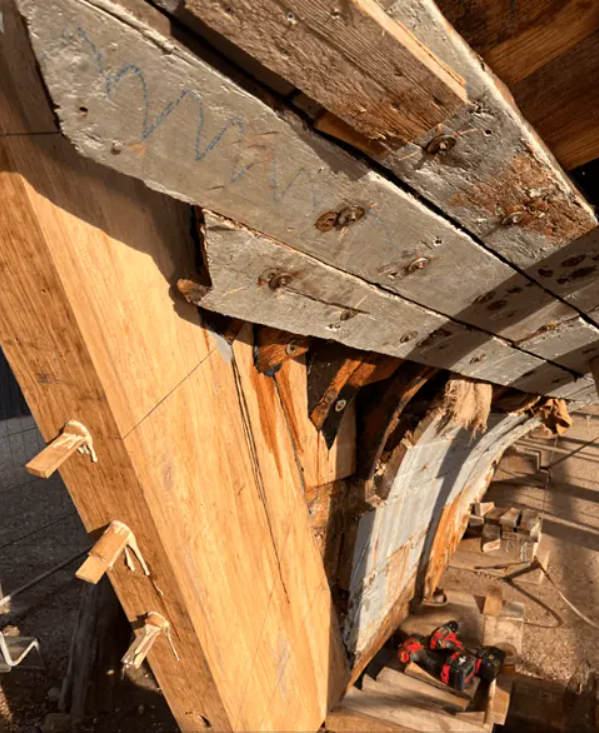
You are probably aware that we are using trunnels (wooden pegs and modern glues) on Gamecock rather than metal fixings, but do you know why? There are two good reasons, both relating to the environment.
Firstly, when cutting curved pieces of timber out of planks there is inevitably a high amount of waste: and Gamecock has a lot of curves! This is particularly distressing when the timber is rare and expensive hardwood. So there is an immediate benefit if we can cut the pegs out of the waste hardwood. The fixture is at least as strong as metal nuts and bolts. In a test on the East Quay the Volunteers had great fun using trunnels when moving their workshop, a large metal container full of tools.
Secondly, we are expecting the use of trunnels to extend the life of Gamecock beyond 60 years. The April 2024 edition of the American magazine ‘Wooden Boats’ has several articles expounding the benefits of trunnels following the capsize in 2017 of a 25 foot Nordic Folkboat built in 1951. When the craft was recovered it was clear that the metal keelbolts holding the one-ton cast-iron keel had come away and all of the ballast was now on the bed of a Norwegian fiord. Outwardly the keelbolts looked healthy but they had corroded to thin needles because of galvanic action and acidity in the oak.
Apparently as the metal corrodes it diffuses positive ions in to the water so that only electrons remain in the iron and they react with water and oxygen to produce rust. Stainless steel is less prone to this process but the more resistant forms are significantly more expensive and, off course, do not utilise the waste oak. The other consideration is corrosion of metal fixtures from the acidity released by wet, salty timber. Oak has a high level of acidity but even Douglas Fir, popular with boat-builders, can degrade metals. Our Volunteers spent over a Year extracting deeply embedded and corroded metal fixtures from timbers on Gamecock that we wished to retain.
When trunnels are used they need to be of a similar density to the wood they are fixing. If the trunnel is too dense then it is likely to split or distort the timber in to which it is being driven: if not dense enough then it is likely to come loose over time. So, in the case of the Gamecock the waste oak is ideal for fixing to the oak frames and fits well with our attempts to protect the environment.
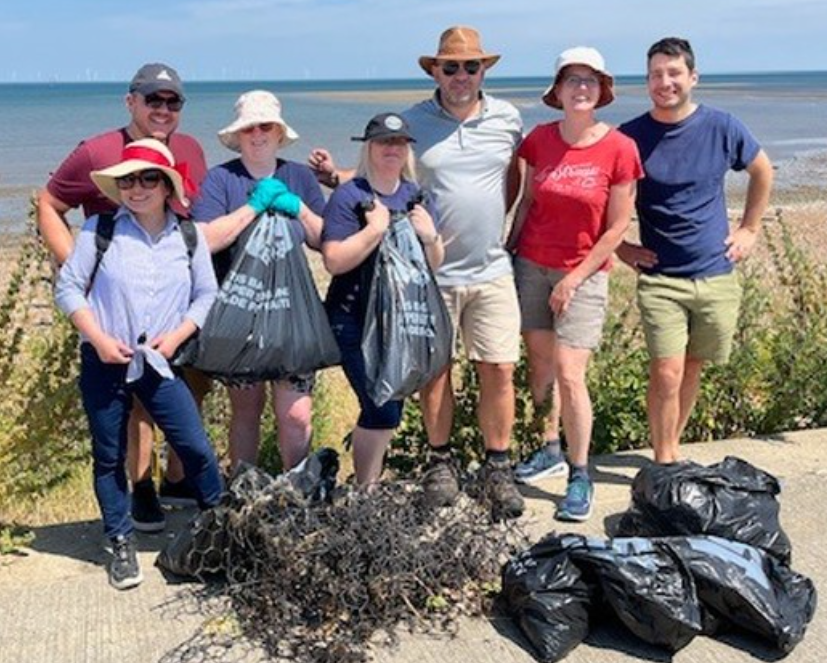
Great Beach Clean by Whitstable Maritime team!
Top find: toy soldier!
Surprise find: lots of wire mesh!

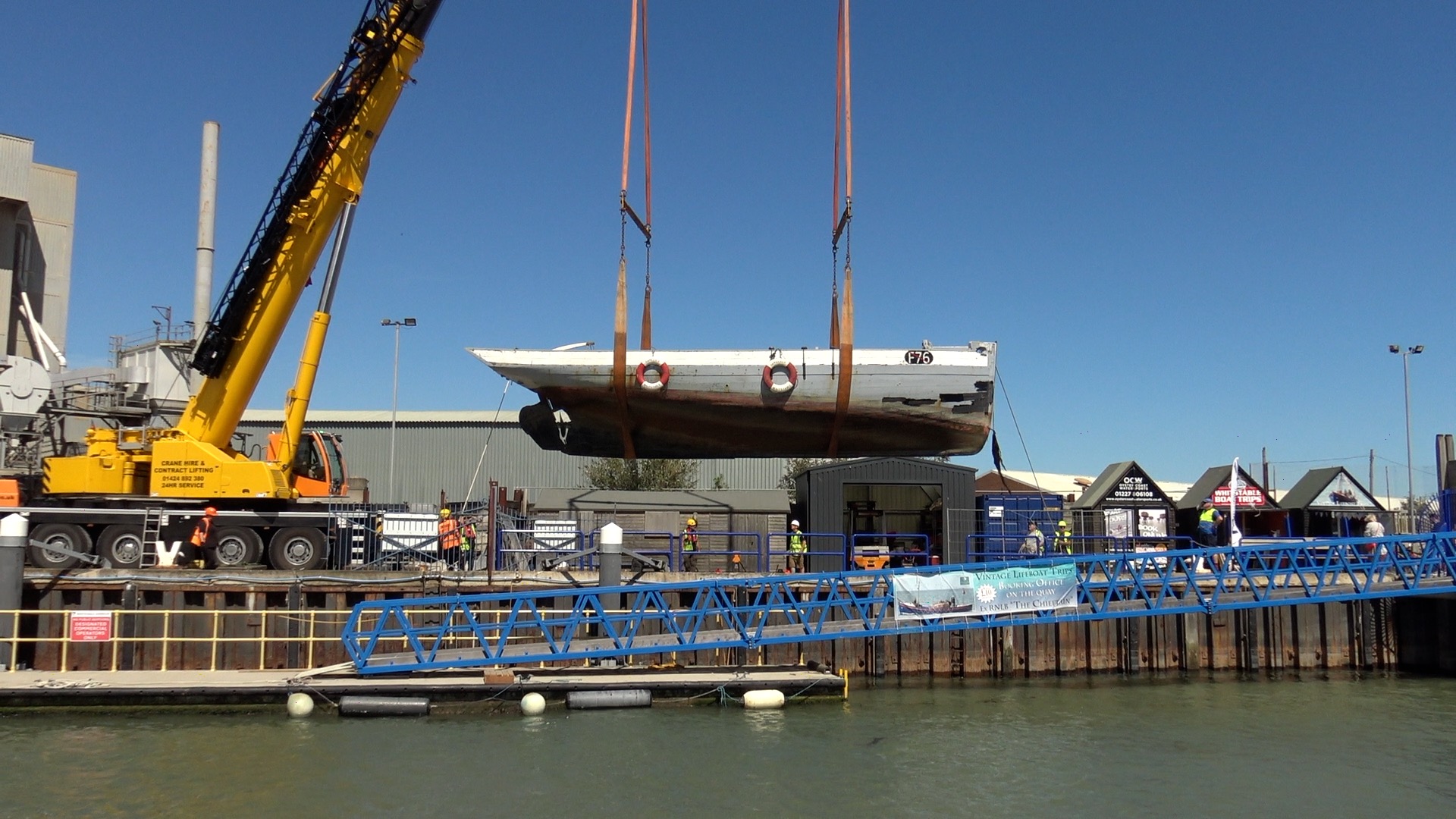
Whitstable Maritime has been awarded a ‘Pride in Place’ Grant in support of the Gamecock’s restoration.
Canterbury City Council (CCC) is the local lead authority for the UK Shared Prosperity Fund which is a central pillar of the UK government’s Levelling Up agenda and provides £2.6 billion of funding for local investment by March 2025. The Fund aims to improve pride in place and increase life changes across the UK investing in communities and places, supporting local business, and people and skills. For more information, visit https://www.gov.uk/government/publications/uk-shared-prosperity-fund-prospectus
Whilst the fundamental restoration work has been completed, funding is now required for the next stage of Gamecock’s restoration journey:
Follow the restoration journey on www.whitstablemaritime.org.uk
For more details, or to Volunteer, contact whitstablem@gmail.com
The cockle boats are easy to spot in the Harbour because they are painted a distinctive blue and carry a large hoover on deck that runs the length of the craft. They are here because the Thames Estuary sustains some of the largest populations of common cockles (Cerastoderma edule) in the UK. Reports that the Thames fishery is one of the oldest and most important in Europe with a total of 2560 tonnes of cockles being landed in Kent in 2022, worth over £1.75 million.
The cockle enjoys clean sand, muddy-sand, mud and muddy-gravel as found in tidal estuaries because they are a shallow burrowing bivalve. They live within the top 5cm of the surface of the mud so they can reach the overlying water for feeding and respiration. Cockles are active suspension feeders using a siphon tube to hold the food suspended in the water column. The shell reaches a maximum length of 5cm. The outer shell is off-white, yellowish, or brown.
Most cockles live for 2-4 years, but some individuals have been found to be over 10 years old. The cockle’s predators are brown shrimp, shore crabs, starfish, snails, worms, flatfish species and a variety of wading birds such as oystercatchers and knots. Cockles mature after 2 years, spawning in the summer when individuals can produce 200,000 to 700,000 eggs per animal. Cockle larvae are planktonic and spend 3-5 weeks floating in the sea before they metamorphosise and settle on the seabed between May and September.
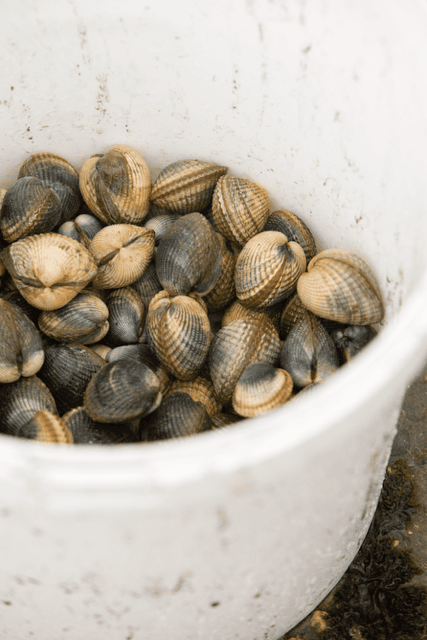
The Thames cockle fishery is the only Marine Stewardship Council (MSC) certified fishery in Kent. The fishery is limited to what they can catch during specific months of the year and can only harvest cockles of a minimum size and quantity. This makes sure the shellfish have time to reach maturity and reproduce which is a key part of fishing sustainably. It also factors in the needs of estuary wildlife such as wading birds that overwinter on the tidal banks and feed on the cockles.
The large pipe on deck is the Hydraulic Suction Dredge used to capture the cockles. This is one of the few methods allowed to harvest cockles and is the most efficient. The Kent boats fish by towing the hydraulic dredge along the seabed at speeds between 2 and 6 knots. The blade on the dredge is set to penetrate a minimum depth of 5cm. and the minimum landing size is 16mm. The fishing season runs from July to October.
This item is based on an article provided by Max Renton, a Consultant with Adonis Blue Environmental Consultants, associated with Kent Wildlife Trust, is an ecological consultancy which returns all profits to conservation work in Kent.
The typical Whitstable Oyster Yawl was between 40 and 45 foot in length. There were exceptions, for example the Rosa & ADA (F105) was 47 foot and Thyra was only 36 foot. For the yards along Island Way these were relatively small. Much larger craft were built on the slipways and then let down in to the sea at a time when there was no sea-wall.
If you are interested in learning more about the larger vessels, then the Merchant Ships of Whitstable by Wallace Harvey (Emprint Publications, 1993) is a good source.
| NAME | BUILDER | BUILT | TYPE | TONS |
| BELMONT | Whitstable Shipping Co. | 1895 | Schooner | 139t |
| EQUIVALENT | James Daniels | 1847 | Schooner | 187t |
| FANNY GANN | Thomas Gann | Schooner | 97t | |
| GRATITUDE | Whitstable Shipping Co. | 1875 | Barquentine | 298t |
| HANNAH | William Blackman | 1841 | Schooner | 113t |
| MARY ANN GANN | Thomas Gann | 1847 | Schooner | 177t |
| NELLIE S. | George Henry Gann | 1876 | Brigantine | 282t |
| SUNSHINE | Whitstable Shipping Co. | 1890 | Ketch | 119t |
| TANKERTON TOWER | Goldfinch Bros. | 1884 | Schooner | 118t |
| ZEBRINA | Whitstable Shipping Co. | 1973 | Schooner | 156t |
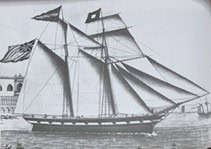
Fundamental structural work has had to be undertaken … look at Gamecock’s skeleton.


At the recent Whitstable Boatyard Reception, the Charity was pleased to present Peter Kalopsidiotis with a gift in recognition of his contribution as a Volunteer to the restoration of the Gamecock. The Charity has also proposed to National Historic Ships that Peter should receive the National Volunteer of the Year Award. The citation read as follows. Peter joined Whitstable Maritime’s restoration team in 2019 when the Gamecock was lying on a mud berth in Faversham Creek where she stayed throughout the pandemic. It quickly became apparent that he was keen to learn new skills and was soon leading the small group that kept her dry and protected the craft when the wind and high tides threatened to drive her ashore.
In 2020 the Charity persuaded Whitstable Harbour Board to allow the Gamecock’s restoration to continue on the East Quay of the harbour. Peter organised a successful tow (photo) from the top of Faversham Creek which involved judging the tides in Faversham and Whitstable.
Once installed on the Quay, under the direction of our new Shipwright, Peter’s team of Volunteers set about removing the rotten timbers and fittings (photo). He forged a good relationship with the Shipwright and it has become an effective partnership with Peter helping to establish a small boatyard and workshop extending to neighbouring premises provided by Brett Aggregates (photo). Peter’s ‘hands-on’ approach involves him being at the site several times a week.
Peter has joined the Board of Whistable Maritime as the Vice-Chair responsible for the restoration project and actively participates in the purchase of materials with the Shipwright, including visits to the local sawmills who now source our oak, larch and pine. Currently they are stress-testing trunnels and researching sails and rigging.
Clearly, many have contributed to the restoration and continue to do so, but Peter has become a key Volunteer in the process and hopefully will become a member of the crew when Gamecock returns to the water in 2025.
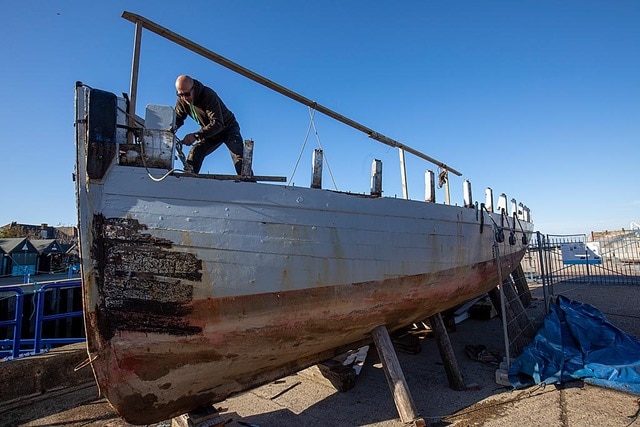
The sight and sound of Oyster Yawls being built on Island Wall is fast fading from the collective memory. Yet today in Whitstable Harbour you can see local Volunteers restoring a 42-foot Yawl built in 1906 and now registered as a National Historic Ship. Marine Surveyors predict that this iconic vessel will have a second working life of 60 to 80 years because of the high quality of workmanship.
The Yawl known as Gamecock was built by Collars Alley by the Collars Brothers and worked all her life in the Swale. Three generations of the family watched the Gamecock being lifted on to the East Quay where Whitstable Maritime has created a boat-building yard with the help of the Harbour Board and Bretts.
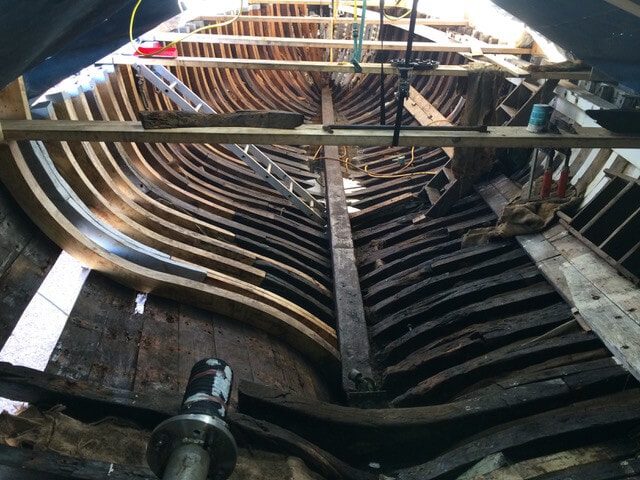
The current team of Volunteers is led by a master Shipwright trained by Alan Staley of Faversham, himself an apprentice of Anderson, Rigden & Perkins of Island Wall. The Charity is looking to have its own apprentice so that the traditional craft skills are retained in Whitstable.
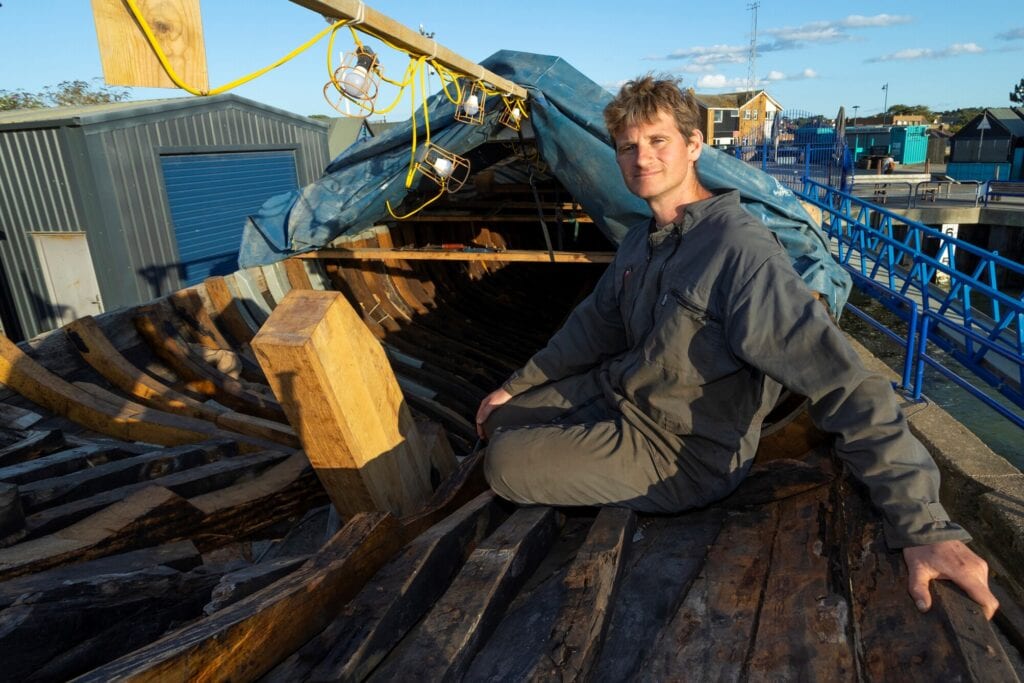
Morgan Lewis with Gamecock on the East Quay in 2013 by when the oak frame had been restored along the length of the hull. Approximately 30% of the original timber was able to be retained. Morgan gained his skills as a Shipwright with Alan Staley of Faversham who, in turn, was apprenticed to the last boat-builder on Island Wall. The protruding block of timber is the top of the new stern post built from laminated oak.
The stern post is fixed to the bottom of the hull by 4 trunnels (long wooden pegs) and modern glues. The trunnels are made by the Volunteers from pieces of oak left after the curved frames had been cut. So waste is kept to a minimum. This traditional technique gives a very strong fixture and avoids the use of metal bolts which can corrode in sea-water over time.
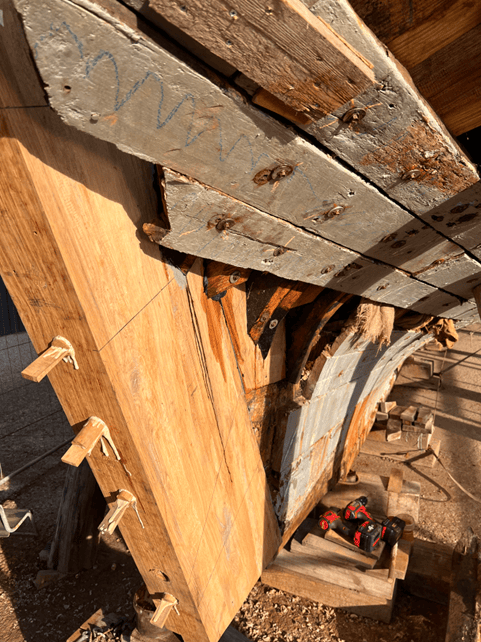
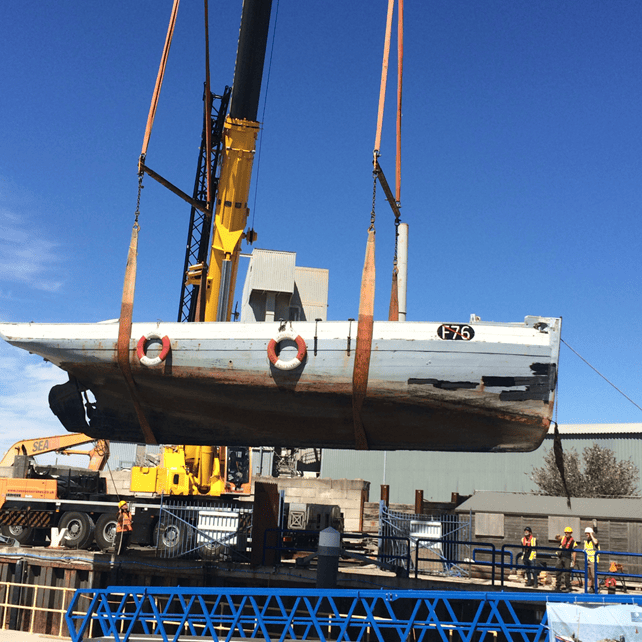
Gamecock being craned out of the water on to Whitstable Maritime’s temporary ‘boatyard’ on the East Quay of the Harbour prior to restoration. Although 43-feet long, the sleek lines of the hull help her sail well in a light wind. The counter-stern (over-hanging deck at the rear) increases the work platform and is a distinguishing feature of a Whitstable Oyster Yawl.
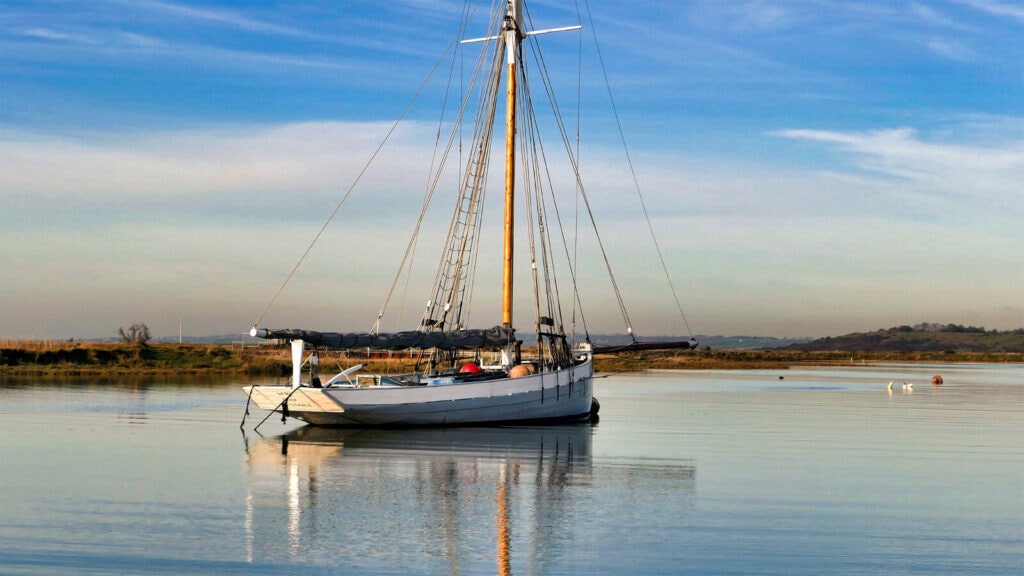
Faversham boat-owners were used to seeing the Gamecock moored at the mouth of the Oare. She was one of over 70 Whitstable Oyster Yawls that worked in the Swale.
Thanks to Whitstable Maritime, this rare craft has been saved from a watery grave and is being fully restored in Whitstable Harbour by local Volunteers. You can help thousands of local folk enjoy sailing her by donating on this website.